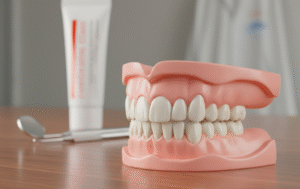Dental fillings are a common treatment for addressing tooth decay, restoring both the function and appearance of affected teeth. While most people associate fillings with molars, front teeth may also require fillings due to cavities, fractures, or other damage. In this guide, we’ll cover everything you need to know about dental fillings for front teeth, including materials used, the procedure, benefits, and aftercare.
What Is a Dental Filling for Front Teeth?
A dental filling is a restorative treatment used to repair a tooth damaged by decay or injury. For front teeth, fillings not only restore function but also need to be aesthetically pleasing to blend seamlessly with the natural teeth. Fillings for front teeth are typically made from materials like composite resin, which can be color-matched for a natural appearance.
Why Might Front Teeth Need Fillings?
There are several reasons why a front tooth might require a filling:
- Cavities: Tooth decay can occur on any tooth, including the front ones, often due to plaque buildup or poor oral hygiene.
- Chipped or Cracked Teeth: Accidents or biting on hard objects can cause damage that requires a filling to restore the tooth.
- Worn Enamel: Grinding or acidic foods can wear down enamel, leading to sensitivity or damage that needs repair.
Types of Filling Materials for Front Teeth
1. Composite Resin
Composite fillings are the most popular choice for front teeth. They are tooth-colored and provide a natural appearance, making them ideal for visible teeth.
2. Glass Ionomer
This material releases fluoride over time, which can help prevent further decay. It’s often used for smaller cavities and is less durable than composite resin.
3. Porcelain
Porcelain fillings are highly aesthetic and durable, often used for more extensive repairs. However, they may take more time and effort to place.
The Procedure for Filling Front Teeth
1. Examination and Diagnosis
The dentist begins with a thorough examination and may use X-rays to assess the extent of damage.
2. Anesthesia
If necessary, local anesthesia is administered to numb the area and ensure a pain-free experience.
3. Cleaning and Preparation
The decayed or damaged portion of the tooth is removed, and the area is cleaned to eliminate bacteria and debris.
4. Placement of the Filling Material
The chosen filling material is carefully applied in layers and shaped to match the natural contours of the tooth. For composite fillings, a curing light is used to harden the material.
5. Polishing
The filling is polished to ensure a smooth surface and a natural look.
Benefits of Dental Fillings for Front Teeth
1. Restores Functionality
Fillings repair the tooth, allowing you to bite, chew, and speak properly.
2. Aesthetic Enhancement
Modern materials ensure that the filling blends seamlessly with your natural teeth, enhancing your smile.
3. Prevents Further Decay
By sealing the tooth, a filling prevents bacteria from entering and causing additional damage.
4. Long-Lasting Solution
With proper care, fillings can last for many years, providing a durable solution to tooth damage.
Caring for Your Front Tooth Filling
Proper care is essential to maintain the integrity of your filling and overall oral health.
- Brush and Floss Regularly: Maintain good oral hygiene to prevent new cavities from forming.
- Avoid Hard Foods: Chewing on hard objects like ice or pens can damage fillings.
- Use a Mouthguard: If you grind your teeth at night, a mouthguard can protect your fillings.
- Visit Your Dentist: Regular check-ups ensure that your fillings remain in good condition.
Potential Challenges with Front Tooth Fillings
1. Staining
Composite fillings can stain over time, especially with frequent consumption of coffee, tea, or tobacco.
2. Chipping
While durable, composite fillings may chip or wear down, particularly under heavy pressure.
3. Sensitivity
Some patients experience temporary sensitivity to hot or cold foods after getting a filling.
Alternatives to Fillings for Front Teeth
In some cases, a filling might not be the best option. Alternatives include:
- Dental Bonding: This procedure uses composite resin to repair minor chips or cavities, similar to fillings.
- Veneers: Thin shells placed over the front surface of the tooth to mask imperfections or damage.
- Crowns: For extensive damage, a crown may be used to cover and protect the entire tooth.
Hummingbird Dental: Richmond Hill’s Leading Emergency Dental Clinic
When a dental emergency strikes in Richmond Hill, Hummingbird Dental is the clinic you can count on for immediate, high-quality care. Located at 10376 Yonge St #202, Richmond Hill, ON L4C 3B8, Hummingbird Dental is renowned for its responsive and compassionate approach to emergency dental situations. Whether it’s a sudden injury, a painful toothache, or a dental issue that needs urgent attention, the experienced team at Hummingbird Dental is ready to help.
Contact Hummingbird Dental at +1 647-370-2024 or via email at info@hummingbirddental.ca to receive the emergency dental care you need. Their team is dedicated to providing quick and effective treatment to alleviate pain and protect your oral health.
FAQs About Dental Fillings for Front Teeth
1. How long do fillings for front teeth last?
Composite fillings typically last 5 to 10 years with proper care, though this can vary depending on the individual and material used.
2. Will the filling be noticeable?
No, modern composite fillings are designed to match your tooth color, making them virtually invisible.
3. Can a front tooth filling fall out?
Fillings are durable but can loosen or fall out due to trauma, decay, or wear. Regular dental visits can help detect and address issues early.
4. Is the procedure painful?
The process is usually painless, as local anesthesia is used to numb the area. Some patients may experience mild discomfort during or after the procedure.
5. How much does a front tooth filling cost?
Costs vary depending on factors like material and the extent of damage. Consult your dentist for an accurate estimate tailored to your needs.
Conclusion
Dental fillings for front teeth are a practical and aesthetically pleasing solution for addressing tooth decay, cracks, or chips. They restore functionality, enhance your smile, and help maintain oral health. With options like composite resin and glass ionomer, your dentist can create a natural-looking filling that blends seamlessly with your teeth.
Proper care and regular dental check-ups ensure the longevity of your filling, keeping your smile healthy and vibrant. If you’re considering a dental filling for your front teeth, consult your dentist to determine the best approach for your unique needs.










